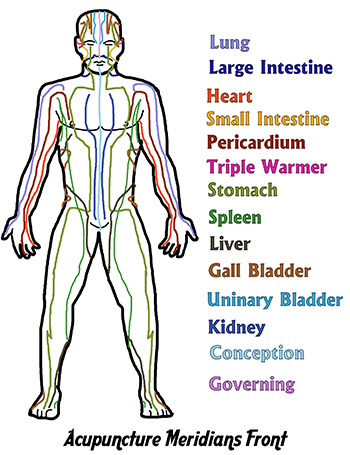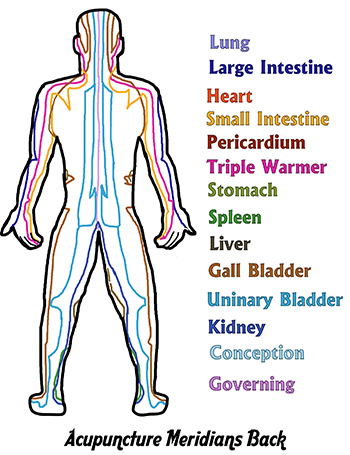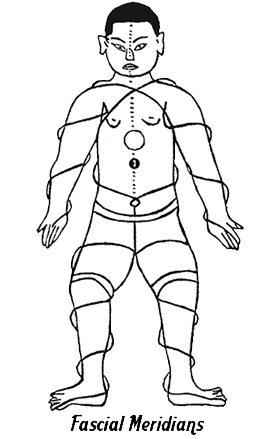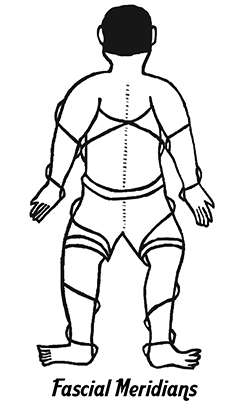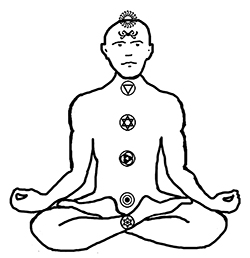
The Pathways of Qi
Thousands of years of knowledge identify the natural flow of energy in the body for health and martial applications.
Energy Meridians
Chinese Medical Theory dates back to the Yellow Emperor. For the thousands of years since, healers, doctors, martial artists, and metaphysicans have studied and refined the understanding of how energy moves through the body. The animating or "life" force moving inside a living person requires great sensitivity to understand in detail. It is easy to discern the living from the dead, but exactly the difference is eludes conclusive understanding.
Chinese and Tibetan medical doctors who have learned the art of reading pulses detect subtle differences related to the twelve primary meridians used for acupuncture. Each meridian associates with an organ. Yin organs are the solid organs the Kidneys, Liver, Heart, Spleen, and Lungs. The Yang organs are the hollow organs the Bladder, Gallbladder, Stomach, Small Intestine, and Large Intestine.
In addition to the twelve primary meridians related to the organs, there are the central channel meridians. The Governing meridian or vessel begins at the perineum and runs up the back along the spine, over the top of the head to the upper lip where it connects to the Conception Vessel which descends down the front of the body through the navel and genitals until it connects with the Governing Vessel at the perineum.
Myofascial Meridians
Surrounding every cell, every tissue, every organ, every muscle, and every bone is a tissue known as fascia. Also known as the sinews, fascia links every part of the body. The fascia are connected throughout the body. Taijiquan derives its power when the alignment of the skeletal system and fascial meridians transmit in an unbroken line from the ground to the extremities. Relaxation is key to be able to utilize the connective tissue to act as a conduit for the Qi to flow and the "Jin" (trained power) to release.
There is a difference between muscle tension and blockages along the fascial meridians. Injuries and chronic tension cause adhesions along the pathways. Like electrical wire transmitting power, a hose directing the flow of water, or a mechanical camera remote trigger, the outer shape remains still while inside the channel the flow moves from end to end. According to Yin/Yang theory movement and stillness are co-dependent. Stillness is the place movement commences. In moving the subtle quality of Qi through the body, it is most easily learned by keeping the outer posture still and feeling the inner movement.
Nervous System Meridians
The entire body is connected by nerves. They transmit messages to the brain where they are interpreted. Taijiquan emphasizes softness, resilience, and sensitivity. Rather than moving and imposing your will or resisting your opponent, your attention is focused on being attentive to what is happening in present time. Nerves response is slower than fascial response in part because the messages travel from the point of contact to the brain to be interpreted and then back out to the point of contact to respond. The fascia do require the transmission of information. Instead, fascia behave like a spring essentially responding instantly.
In Taijiquan you rely on your ability to feel. Although in the early learning phase you concentrate in a very conscious way on the replicating the method you've been taught, true understanding occurs through experience and only afterwards will your descriptions be grounded. As you continuously investigate the principles of Taiji, your understanding will come in the form of new discoveries—even as you exclaim with words you have spoken before. The revelations you experience are your deeper comprehensions of meanings you thought you understood.
Circulatory System Meridians
Throughout the body, blood flows from major veins and arteries to the tiny capillaries. Nourishment from air, water and food pass through the blood to provide you the fuel for living. The heart pumps the blood to reach the furthest extremities. The blood passes through each of the organs where nutrients are extracted for the body's functions and unusable wastes are removed to keep the system functioning efficiently.
The ability to process the substances of air, water, and food keeps the body functioning through time. The changes flow constantly. The body's ability to sustain and thrive proceeds to facilitate the functioning of other systems such as the endocrine system with its hormonal glands. The yogic traditions describe seven primary energy centers that run parallel to the spine. The chakras help separate and define specific life functions.
Starting at the base of the spine and moving upward to the crown of the head, the chakra locations correspond to the locations of the major endocrine glands. Below are the chakras are briefly described along with the corresponding glands, and functions:
• (1st) Root chakra is located at the base of the spine. It relates to the basic feelings of survival. It corresponds to the reproductive glands controls sexual development and secretes sex hormones.
• (2nd) Sacral chakra is located across from the sacrum on the back side of the pelvis. It relates to creativity and the power sexual passion. It corresponds to the adrenal glands and core vitality by regulating the body's metabolism.
• (3rd) Solar Plexus chakra associates with the will and sense of power in the world. It corresponds to the pancreas where it regulates the blood sugar balance and digestive absorption.
• (4th) Heart chakra is located at the center of the chest. It is the balance point between the lower three earthbound chakras with the upper three chakras and their inspirational and spiritual purposes. It is corresponds to the thymus gland, compassion, and is responsible for balancing the energy of the chakra system.
• (5th) Throat chakra is located in the neck. It relates to expression and communication. It corresponds to the thyroid gland, which regulates body temperature and metabolism.
• (6th) Third Eye chakra is located in the center of the forehead. It relates to insight and perception. It corresponds to the pituitary gland and relates to awareness and awakeness.
• (7th) Crown chakra is located at the top of the head at the junction of the sutures in the skull (the fontanel) where the bones fuse after birth. It relates to It relates to wisdom and connection to the universal source. It corresponds to the pineal gland.
Lymphatic System Meridians
Taiji is an exercise for the joints. It emphasizes exercising tendons, ligaments and the connective tissues of the body as opposed to the muscles. Muscles are used, but motion is produced while sustaining their relaxation. In part, this is accomplished by confining movements to their most comfortable range.
Tendons and ligaments are used to retain the body’s natural shape so that the muscles can remain without tension. Postures are designed so that muscles are never over-stretched, and at the same time, are prevented from becoming too loose. Moving slowly allows the focus to remain clearly on subtle sensations, so that movements can be done optimally.
The Movement of Fluids in the Body
In Taijiquan, the body works as a single integrated unit. All the power begins in the feet and moves progressively through the body until it is expressed in the hands. As a consequence, the power created in movement is much greater than it would otherwise be. For instance, instead of being pushed by a finger, the hand pushes the finger; the arm pushes the hand; the torso pushes the arm; the legs push the torso.
